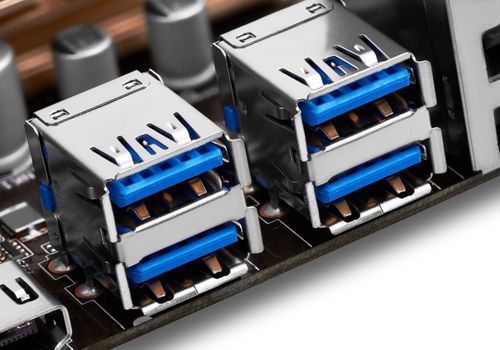
Each version of the USB technology standard has its own color coding. For example, black is assigned to USB 2.0, while Red means USB 3.2.
This was recently brought to my attention after a friend asked me about color coding on USB ports and what different colors mean. Luckily, having spent time as a PC service technician, I know the meaning behind various USB port colors, so I was able to explain what different colors mean.
In this article, I'll discuss USB color coding and what different USB port colors mean. So, without further ado, let's dive right in.
Contents
USB ports are found on desktop computers and laptops, and besides the more popular USB Type A, we were recently introduced to USB Type C ports. Of course, most devices still use the older Type A port for power and data transfer, but Type C offers faster data write/read speeds and better power transfer.
However, there's another distinction between USB ports, most specifically in USB Type A, and that's color coding. You might have noticed that some devices sport USB ports in different colors, including blue, black, teal blue, yellow, and even red. But why do these ports sport different color coding, and is there some meaning behind the port's color?
For the most part, the color of the USB port represents the port's version, but there are some notable distinctions that are tied to the port's function. Keep in mind that while the use of these colors is common, manufacturers don't always adhere to color coding established by Universal Serial Bus Implementers Forum.
For example, some devices, like USB hubs, feature colored USB ports for decorative purposes. There are also some ports that have USB 1.0 color coding, but they're actually USB 3.0 ports. This is a general guide on USB port colors, and while most hardware manufacturers comply with the official color coding, it's not surprising to see different colors on different ports.

Most devices use USB Type-A host (also called "female") ports, and if you look at any of them, they all look pretty much the same. However, each color actually represents a different type of connection. Here's what each color means:
The white USB port is also known as USB 1.X. Version 1.0 debuted in January 1996, featuring a Full Speed data transfer of 12 Megabits Per Second (Mbps). Despite being the official commercial debut of the Universal Serial Bus technology, very few products actually used it.
USB 1.1, on the other hand, was much more successful than its predecessor. It launched in August 1998 and led to broader commercial adoption of USB. Its drawback was that the data could be transferred in one direction only, but the tech became so popular that it led to the creation of legacy port-free PCs.
Black USB ports are known as USB 2.0, which was a USB port specification released in 2000 with much higher bandwidth compared to white USB ports. These could only transfer data in one direction at a time, but they featured exceptionally high transfer speeds of up to 480 Mbps.
The black USB 2.0 ports offered the same capabilities as the white ports but better transfer speeds and overall reliability. They were designed to function with various devices, including keyboards, mice, mics, speakers, external storage devices, and USB flash drives — whose creation was most likely prompted by the USB 2.0 spec.
The blue USB port is known as USB 3.0 or SuperSpeed USB, which was introduced in 2008, and has improved ever since. USB 3.0 ports support a transfer speed of up to 5 Gbps, which is roughly 10 times more than what USB 2.0 has to offer.
USB 3.0 ports are very interesting; they're the first ports that support duplex communication. This means that they can transfer data in both directions at the same time. They're also backward compatible with USB 2.0 and USB 1.X standards, but the data transfer speeds are limited to the capabilities of lower specifications.
The USB 3.0 was superseded by the 3.1 specifications, which preserved the data transfer speeds. Effectively, only the name was changed from USB 3.0 to USB3.1 Gen 1.
Teal Blue USB Ports represent USB 3.1 Gen 2, also known as SuperSpeed+ USB ports. They were released in 2013, with an increased data transfer speed of up to 10 Gbps, which is double the speed of previously launched USB 3.1 Gen 1 USB ports.
Besides offering incredible transfer speeds, the teal USB port is backward compatible with devices that use USB 3.1 Gen 1 (former USB 3.0), as well as USB 2.0 and USB 1.X standards. Teal USB port also supports duplex communication, but the transfer speeds are limited to guest devices or devices with lower specifications.

The introduction of USB 3.2 brought massive changes to the 3.X specifications, as it encapsulated all the previous specifications. So, technically speaking, all the newest devices that use the USB 3.X standard are USB 3.2. This means that the previously called USB 3.0, which became 3.1 Gen 1, is now called USB 3.2 Gen 1.
Likewise, the USB 3.1 Gen2 became the USB 3.2 Gen2. It's still important to remember that the designations have changed, but the specifications haven't. Red USB ports are USB 3.2 ports, but they can also be USB 3.1 Gen 1 and USB 3.1 Gen 2 ports as well, depending on how the device's manufacturer decided to name the USB specification.
However, the Red USB port has additional functionality. Unlike the USB 2.0 or Blue USB port, the red USB port is a Sleep and Charge port or Always On port. This means that the USB port delivers power even when the host device is power-off or hibernating/sleeping.
Additionally, these ports provide a higher power output, allowing you to charge your devices faster than using a normal USB port. We'd like to mention that some manufacturers use an Orange USB port instead of a Red one. The change in color doesn't affect the USB specification, which is limited to USB 3.2
Yellow USB ports are the same as Red USB ports, but with a single distinction — they also work with Black USB port specifications (USB 2.0), as well as USB 3.2. Just like Red USB ports, Yellow ports are also Charge and Sleep or Always On ports, which allow you to charge your device while the host device is powered off, or in sleep mode.
However, it would seem that Yellow USB ports are more present on laptops rather than desktop computers. Whether or not this is by design isn't specified by the USBIF.
The USB port has been crowned the king of ports, and with the advent of USB Type C 3.2 Gen 2x2, the USB is more powerful than ever — a true king of USB connectors. However, in the end, it's that cable or port that simplifies your life when you use your laptop to access your peripherals, save files, or charge your phone.
